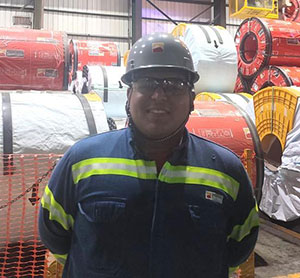AIST Foundation Steel Intern Scholarship
Erick J. Villarreal Valle
My overall objective was to identify the possible causes of failure events in the pan used in the process, as it is extremely important within the process to have the necessary coating to produce a quality product.
In seeking solutions that would allow for a new implementation in line with the high standards currently in place, it was necessary to understand the process, both the theoretical part described in the reports and the practical way in which the operators carry it out. From this point, the most relevant and comparative information was obtained in order to have a complete overview of the current operating conditions.
 Now that we understood the process, the variables involved, its configuration, and purpose, it was time to search the literature and operators’ experience for possible failures in previously recorded events. At this point, hypotheses were put forward and, as we progressed, they were ruled out due to a lack of evidence of system failures or due to variables or conditions that did not match, in order to give it a more specific focus and seek appropriate solutions.
Now that we understood the process, the variables involved, its configuration, and purpose, it was time to search the literature and operators’ experience for possible failures in previously recorded events. At this point, hypotheses were put forward and, as we progressed, they were ruled out due to a lack of evidence of system failures or due to variables or conditions that did not match, in order to give it a more specific focus and seek appropriate solutions.
To get started on the topic, general research had to be conducted on refractories, drawing on literature from different sources to begin to understand the material, answer questions about the behavior of the material in the process, and determine whether this had an impact on the failure events that occurred on the line.
To keep everything organized and meaningful, a schedule was created that outlined the order of activities to be carried out to achieve the common goal from the outset. During the process, a failure analysis was performed. The information gathered from the failure analysis was that in the periods prior to the dates of the events recorded, there were power failures in all cases, causing the system temperature to vary abruptly, oscillating between constant loading and unloading cycles that are part of the process. Another issue detected in the operational area was the mechanical impact on the refractory caused by the feedstock. With this in mind, these critical points were addressed, and the investigation focused on them in order to move forward as the process allowed.
Various scenarios and situations that the refractory material might encounter were developed, and graphs were obtained to corroborate or eliminate hypotheses. This was very useful for understanding the behavior of the refractory material in the process. This is more of a simulation, since in the actual process it is impossible to review these points while the process is underway (which is how we want to know).
Based on this research and analysis, viable proposals were generated for implementation in the process, including a modification of the ladle cover to prevent severe mechanical impact, a modification of the feed chute to give the coating a more natural flow, and proposals for backup power systems to avoid consequences when this situation occurs, all of which are intended to protect the useful life of the refractory material used.
I must thank the entire ladle operation team and the technologists in charge of the lines for their support and shared experience, which served as a teaching and learning opportunity. Recognizing their merit, they were instrumental in the knowledge, understanding and implementation of the proposed improvements.
